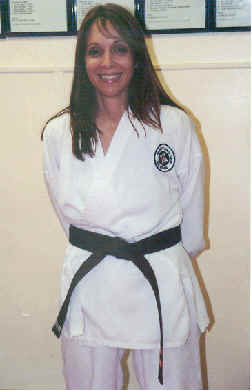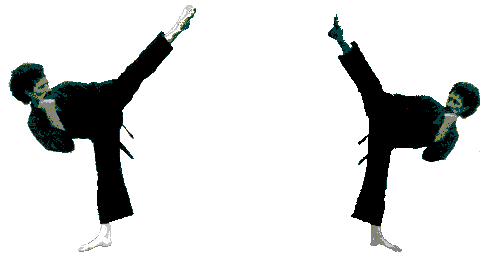Discovering the Joy of Training
When students begin training in Mudokai karate their initial enthusiasm is usually enough to carry them through the first few weeks of practice. Following that initial period they often begin to notice that stretching is sometimes uncomfortable, some techniques are difficult to perform, and many techniques take a lot of practice before they become second nature. It is important at every stage of training to seek the satisfaction that comes from a well-executed technique or movement.
As an instructor I have always done my best to offer positive reinforcement to students during class. Sometimes that reinforcement may be just a word of encouragement or a glance of approval. At other times it might include awarding a stripe or even a rank promotion. While this kind of reinforcement is very positive and helps students to persist in their practice, it is still limited. This is because it is essentially external to the student. The reinforcement is coming from outside, and any external reinforcement is limited.

The more powerful reinforcers for any behavior or practice are those that come from within ourselves. It may be that as we are stretching we feel more balanced than usual. Perhaps the stretch goes a little deeper than we have gone before, or we feel better extension and relaxation as we perform he movement. During practice it may be that the punch that we are executing feels more poised, more powerful, or more focused. When we are working on kicking skills and we notice that our performance of a particular kick felt “just right”, we know that we experienced an improvement. All of these examples illustrate the satisfaction that can be derived when we experience intrinsic reinforcement, that is, an enjoyable or pleasurable experience within our own bodies that is the result of correct posture, body use, and execution.
When we can discover how to perform well enough to perceive the harmony of our body working in tune with itself we experience directly the joy of training. It is this feeling that can motivate and inspire us to train year after year regardless of what external awards, belts, trophies or other reinforcers may, or may not, be present. The goal of the martial arts, in essence then, involves the self-discovery of the joy of training.
Sensei Robert H. Mason © 2002
Sempai of the Month
Nerissa Spannos

The Sempai of the Month is Nerissa Spannos who has trained at UKC since January 2000 and is currently a 2nd Kyu Brown Belt She has been a Sempai since December 7th 2000 and has completed three sides of her sempai sheets. Sensei Mason recommended Nerissa because “she is helpful, knowledgeable and has a great attitude. I find that Nerissa takes direction well and is eager to learn how to teach others.”
Nerissa was born in Texas but left for the Bahamas with her family when she was five years old. Her family traveled quite a bit while she was growing up and she lived outside the United States in England as well before moving back here when she was eleven, when she began training in Judo. She remarked that “at that time girls were not really allowed to train in karate as it was considered more feminine for them to participate in dance, which I took also. These days girls are encouraged to take karate so they will know how to defend themselves”. Nerissa also showed horses, traveling all over the United States, winning prizes.
Working a busy schedule, like most people these days, Nerissa was initially attracted to UKC because of the large number of classes at different times. She found the written curriculum, with its “step-by-step” structure of learning, was also a big plus. Traditionally, many martial arts schools are very informal and teach their material in a haphazard manner making it difficult for the students to follow along. Nerissa also noted that “the instructors who teach the children’s classes are all very supportive and give the kids positive reinforcement which I like”.
One of her “hobbies” is buying old, ugly houses and fixing them up which is also partly related to her job as a Real Estate broker. She has also been working closely with Sensei Mason and Sensei Navarrete on the “Funkicks” aerobic kickboxing home workout video.
Sons John, fourteen, nearly a Brown Belt, and Nick, twelve, a Brown Belt are also students here at the karate school. The boys had trained previously in other karate schools where the atmosphere and discipline was more militaristic (coercive) and the experience more punishing than corrective, leading to them stopping their training. Their Mom convinced them to give UKC a try and they have been here ever since.
When asked what advice she would give to a beginning student her reply was to “stick with it and never give up. I like to work out because afterwards I feel better and I feel stronger”.
SOMEBODY IS ALWAYS WATCHING:
A Secret of the Martial Arts and of Life is “watch yourself”
At the University Karate Center all of the students benefit from a very structured program of reward and “punishment” (correction), which is meant to give students (and parents) a concrete basis for measuring improvement for every student on their path of training. When I first began teaching in 1975 the only colored belts were white, green and brown, leading to Black Belt. I extended this tradition to include the additional colors and red stripes between ranks. This provides ongoing feedback to the students on their progress, and is based upon scientific principals, rather than just tradition. I also instituted the “Sempai” program to develop the students’ leadership skills.

Recently some Junior students were disciplined and red stripes were taken for misbehavior, either during class or before class began. The students seemed surprised to learn that they were being watched, even though the Sensei in charge did not actually see the misbehavior in question.
In another case two Junior Sempai were not the examples that they needed to be in that role for their classmates. Several parents came into the school and complained to the Front Desk. The Sempai in question did not get credit for that particular class and were required to “make up” that time. Another time one of the office staff observed a Junior student hitting a classmate with a pad before class started, and removed a red stripe for bad behavior. The stripe will have to be earned back.
Mudokai training requires discipline because the techniques that the student learns could be dangerous if misused. The correct attitude must be maintained at all times. Karate should be used only in defense, therefore, no hostile or aggressive action can be tolerated in the Dojo. The correct attitude for the student is one of deference, courtesy and respect and that is the foundation of real progress as a “karateka”.
There is a story of a Buddhist farm worker who was told by his boss to kill a chicken. He told the boss that as a vegetarian pacifist he could not kill. The boss proposed that he kill the chicken behind the chicken coop where no one was watching. He came back a few minutes later, the bird still alive in his hand and said, “Even out of sight of everyone else, I was still watching”. Anytime that we do something which we know we should not do, even if no one else sees us, we are still watching. In some ways it is those things we do, good or bad, when no one else is watching, that truly define our character. The truth is that someone is always watching, even if it is just ourselves. We are the one person we can never get away from, and this, of course, is the basis of our conscience. The more that we can be true to ourselves and learn to reflect on our conscience the better we will be, and be seen to be, in Martial Arts and in life.
Sensei Robert H. Mason © 2002